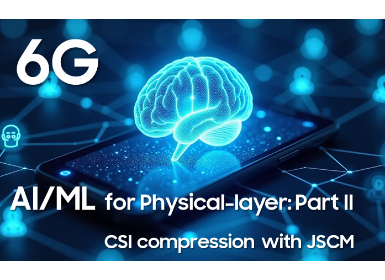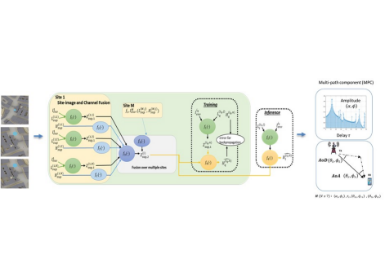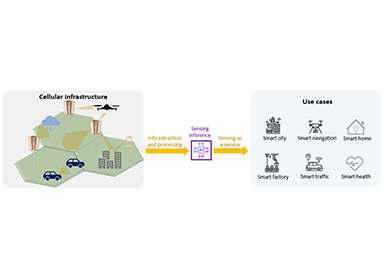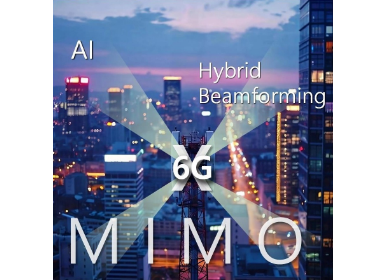Communications
All Set for 6G!
June 2023, ITU-R1 Working Party (WP) 5D2 finalized the Framework Recommendation of IMT-20303 (a.k.a. 6G Vision, hereinafter 6G Framework). This will now undergo the approval process within the ITU, with the final publication within 2023.
In this blog, the main elements of the 6G Framework Recommendation are introduced, including the future plan. Samsung was a leading contributor to this global activity and HyoungJin Choi of Samsung Research chaired this activity within this working party.
1 The International Telecommunication Union (ITU) is a specialized agency of the United Nations responsible for all matters related to information and communication technologies. The ITU Radiocommunication sector (ITU-R) is responsible for radiocommunication.
2 WP 5D is responsible for the overall radio system aspects of the terrestrial component of International Mobile Telecommunications (IMT) systems, comprising the current IMT-2000, IMT-Advanced and IMT-2020 as well as IMT for 2030 and beyond.
3 Draft New Recommendation ITU-R M.[IMT.FRAMEWORK FOR 2030 AND BEYOND]
Work in progress to be considered for approval by ITU-R Study Group 5 (SG 5) in September 2023.
IMT-2030 (6G)
ITU-R WP 5D, the responsible group of standardizing international mobile telecommunication (IMT), agreed on the official name of the 6th generation mobile communication (6G) as IMT-2030, which is expected to be commercialized around 2030 onwards.
IMT-2030 aims to provide immersive experiences, hyper-connections, and hyper low latency services by further improving the service and performance when compared with what is available with existing IMT-2020 (5G). It is also expected to provide new services distinct from 5G through ‘integration of communication and artificial intelligence (AI)’ and ‘integration of communication and sensing’.
Why ITU-R?
There are two essential gateways for the promotion of international mobile telecommunication (IMT) standardization - ITU and 3GPP. ITU is a gathering of 193 member countries together with sector members and academia from various fields. ITU establishes the overall research and development direction, key performance indicators, as well as the standardization, commercialization, and spectrum roadmap for the new generation of IMT through the Framework Recommendation. It then moves on to defining the technical performance requirements to achieve the Framework. Afterwards, 3GPP develops detailed technical specifications that meet the requirements defined by the ITU and submits it to the ITU as a candidate radio interface technology to evaluate whether the technology meets the requirements of the ITU. If it passes the evaluation process, it is approved as ITU-R Recommendation. Figure 1 shows these relationships.

Figure 1. Relationship between ITU-R and 3GPP
Therefore, the finalization of the Framework Recommendation means that global 6G (IMT-2030) standardization is now in full swing.
6G Framework [1]
Starting with the FPLMTS (Future Public Land Mobile Telecommunication System) and the related study question for 3G (IMT-2000) research in 1985, the ITU has been standardizing radio interface technology for each generation since then by presenting its visions for both 4G (IMT-Advanced) and 5G (IMT-2020).
The Vision Recommendations for 4G and 5G defined in ITU-R are as follows:
- 4G Vision Recommendation: Recommendation ITU-R M.1645 (June 2003) “Framework and overall objectives of the future development of IMT-2000 and systems beyond IMT-2000”
- 5G Vision Recommendation: Recommendation ITU-R M.2083 (September 2015) “IMT Vision - Framework and overall objectives of the future development of IMT for 2020 and beyond”
Similarly, in the case of 6G, standardization continued under the term ‘Vision’, but the term ‘Vision’ was decided to be replaced with ‘Framework’ at the 43rd meeting of WP 5D held in February 2023 in response to objections from some member countries that did not prefer the word ‘Vision’. However, the term ‘Vision’ would continue to be widely used in many places around the world and within the industry.
The basic storyline of the 6G Framework Recommendation is as follows: Considering the goals 6G aims for and the direction of societal and environmental needs, it examines trends (users, applications and technology), spectrum implications and evolutionary directions of IMT. Through this, certain usage scenarios will be expected in 6G and goals for capabilities will be set to realize them. In addition, for 6G, a roadmap for technology standards, commercialization, and spectrum from a mid- to long-term perspective is presented.
User and Application Trends
It is expected that a variety of new use cases would be enabled by 6G. By grouping the tens of different anticipated use case candidates together, 9 representative user and applications trends are addressed as follows:
1) Ubiquitous intelligence, 2) Ubiquitous computing, 3) Immersive multimedia and multi-sensory interactions, 4) Digital twin
and virtual world, 5) Smart industrial applications, 6) Digital health and well-being, 7) Ubiquitous connectivity,
8) Integration of sensing and communication, and 9) Sustainability
Usage Scenarios
Based on the 9 user and application trends addressed above, the Framework Recommendation presents 6 usage scenarios of IMT-2030 as follows. Figure 2 depicts 6 usage scenarios and 4 overarching aspects in a wheel-shaped diagram.

Figure 2. Usage scenarios and overarching aspects of IMT-2030
1) Immersive communication: This usage scenario extends eMBB of IMT-2020 and covers use cases which provide a rich and interactive video (immersive) experience to users, including the interactions with machine interfaces.
2) Hyper reliable and low-latency communication: This usage scenario extends the URLLC of IMT-2020 and covers specialized use cases that are expected to have more stringent requirements on reliability and latency.
3) Massive communication: This usage scenario extends mMTC of IMT-2020 and involves connection of massive number of devices or sensors for a wide range of use cases and applications.
4) Ubiquitous connectivity: This usage scenario is intended to enhance connectivity with the aim to bridge the digital divide.
5) Integrated AI and communication: This usage scenario would support distributed compute and AI-powered applications by leveraging data collection, local or distributed compute offload, and the distributed training and inference of AI models across various intelligent nodes, such as base stations and devices in IMT-2030.
6) Integrated sensing and communication: This usage scenario facilitates new applications and services that require sensing capabilities, which makes use of IMT-2030 to offer wide area multi-dimensional sensing that provides spatial information about unconnected objects as well as connected devices and their movements and surroundings.
As described above, 6G is envisaged to pursue an ongoing evolution of three representative usage scenarios of 5G (i.e., eMBB, URLLC, and mMTC) through a continuous development of these three traditional mobile communication areas. In addition, it is expected that 6G would not only enhance performance of communication itself but also extend its utilization to a wide variety of directions by integrating sensing/AI with communication.
Furthermore, 6G is expected to be built on common characteristics, so-called ‘Overarching aspects’, which act as design principles commonly applicable to all usage scenarios. The overarching aspects include, but are not limited to, sustainability, security/privacy/resilience, connecting the unconnected, and ubiquitous intelligence. Initially, those items were proposed as candidates for usage scenarios, but eventually defined as overarching aspects as they could be considered important factors for all usage scenarios rather than showing an exclusive characteristic.
Capabilities
In order to fulfil the six usage scenarios of IMT-2030, various technical aspects and performance requirements need to be considered. The 6G Framework Recommendation defines these technical objectives and requirements items as ‘Capabilities’, and the derived estimated target value ranges of each item for enhancing research and investigation of 6G as shown in the table below. Based on these target values, a detailed value (i.e., a single value) within the range would be developed in the technical performance requirements (TPR) phase beginning year 2024.

Table 1. Capabilities of IMT-2030
Figure 3 depicts 15 capability items in a palette-shaped diagram.

Figure 3. Capabilities of IMT-2030
Ongoing Development and 6G Roadmap
The 6G Framework Recommendation describes the relationship between 6G and existing IMT. Also, it describes the relationship between 6G and other access technologies such as non-terrestrial networks of IMT (including satellite communication systems, HIBS and UASs4 ) and other non-IMT terrestrial networks (including Wi-Fi and broadcast). In addition, overall timelines for technology development, standardization, commercialization and spectrum are described and depicted.
Challenge
ITU makes decisions through consensus building. In other words, standardization cannot be completed if a specific member country opposes. Therefore, unlike organizations that make decisions by voting when it is difficult to reach an agreement through intense discussion, everything is a challenging and difficult journey.
At the 43rd meeting of WP 5D in February 2023, according to the plan, the status of the 6G Framework should have been promoted from a working document to a preliminary draft new Recommendation (PDNR). However, at the 43rd meeting, some items that had not been discussed in the meantime were newly proposed, and it was difficult to obtain the consent of many members and it did not appear that the Recommendation would be agreed at the 43rd meeting. Immediately after the meeting, various meetings and offline discussions were conducted to find ways to resolve the identified issues. During the 44th meeting of WP 5D, Samsung led the discussion and actively contributed to the collaboration across the industries, academia, and governments, in order to find ways to resolve the issues by accommodating various views from members. Based on these efforts, the issues were finally resolved at the 44th meeting in June 2023.
Future Work
At the 41st meeting in June 2022, WP 5D agreed on the timeline for finalizing standardization of the IMT-2030 radio interface technology by June 2030. Following the completion of 6G Framework, WP 5D will now begin to define the technical performance requirements of 6G technology by February 2026. Submission of candidate radio interface technologies from 3GPP and others including ITU member countries is scheduled over the time window from 2027 to 2028 and they will be evaluated for compliance with the technical performance requirements. It is planned that technologies that pass the evaluation will be finally approved in June 2030.
To commercialize 6G around 2030, technology development and standard development should all be performed in a timely manner. At the same time, provisioning of true 6G services can be accomplished by securing necessary spectrum in WRC-27 since WRC occurs every four years. In order to determine 6G spectrum in WRC-27, it is the prerequisite to include candidate spectrum bands as agenda items of WRC-27 at the forthcoming WRC-23 taking place in November-December 2023. We will continue to work hard in collaboration with all the stake holders to secure necessary 6G spectrum.
4 HIBS (High Altitude Platform Stations as IMT Base Station), UAS (Unmanned Aircraft System)
References
[1] Document 5/131, Draft New Recommendation ITU-R M.[IMT.FRAMEWORK FOR 2030 AND BEYOND], Framework and overall objectives of the future development of IMT for 2030 and beyond, June 2023.






